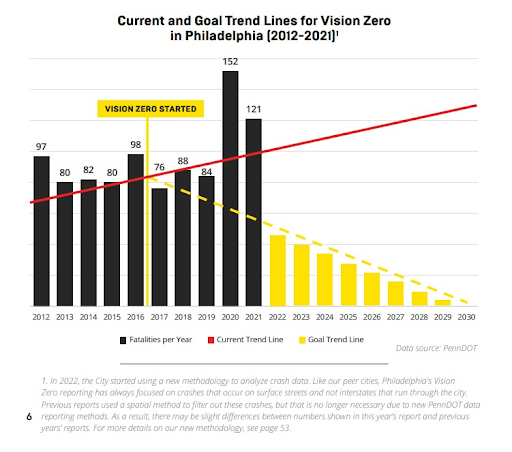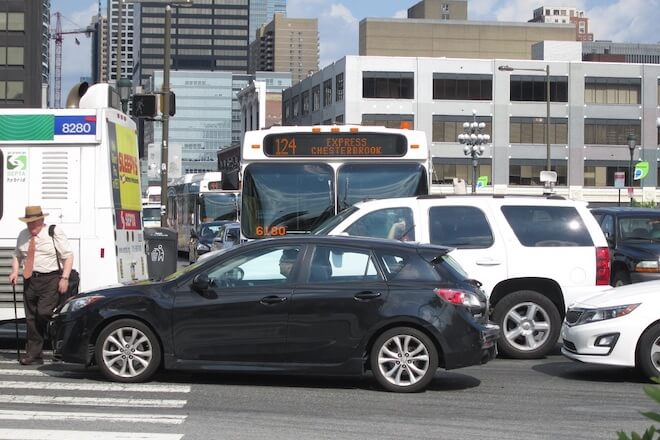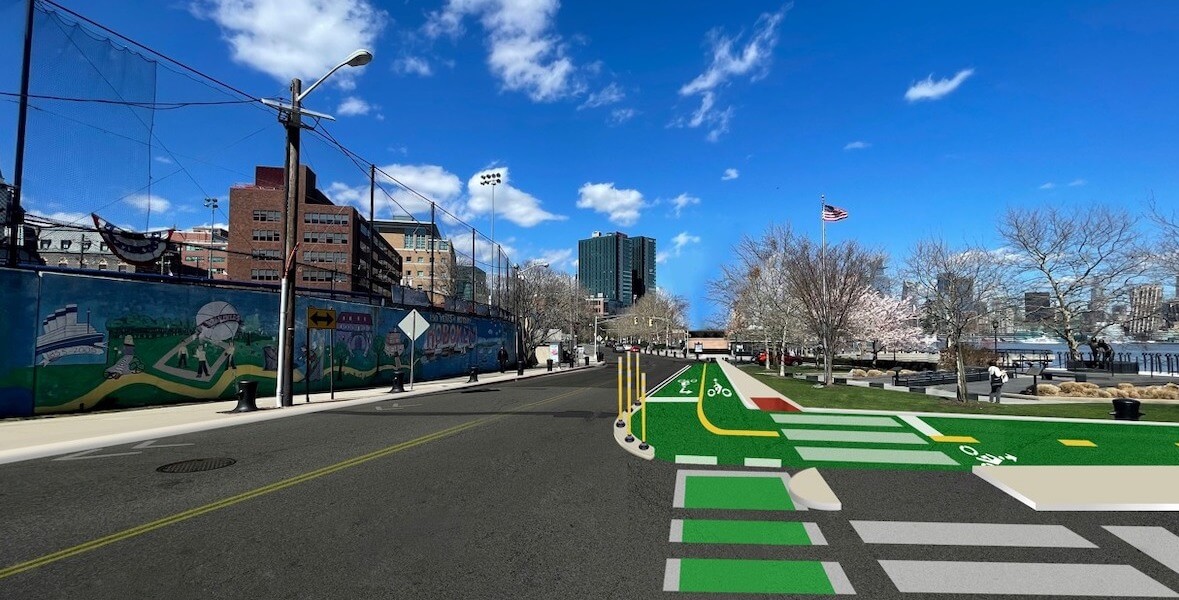Each year, cars kill about 40 pedestrians in Philadelphia’s streets. Add cyclists into the mix, and fatalities jump into the 70s. Depending on the year, that’s 50 to 100 Philadelphians each year who could still (safely) be among us, but are not.
That includes, for example, 28-year-old Nyier Cunningham, killed while riding his bike in West Philly last year. And 66-year-old Taing Sophy, also riding her bike when hit by a car in South Philly this past January. Or 44-year-old Savoun So, struck dead while walking across the street, also in South Philly, earlier this year. And that doesn’t count the dozens of pedestrians and cyclists who are hit by cars but survive every year.
Now take a look at, say, Hoboken, New Jersey. For the past six years, the North Jersey city has had zero fatalities on their streets. Hoboken, you might not be surprised to learn, is a Vision Zero city. What’s that, you ask?
When a city pledges to be a Vision Zero city, they accept five key principles:
-
- All traffic deaths are preventable.
- Preserving human life should be the priority in transportation systems.
- Mistakes happen, so transportation systems must adapt and respond.
- Reforming the system must take priority over reforming human behavior.
- The number one risk factor in traffic deaths is speed.
“Vision Zero,” says Dena Driscoll, chair of Philly’s Fifth Square political action committee (and one of the Citizen’s Generation Change Philly) , “is the idea that it is morally wrong that any person should die from traffic violence.”
Hoboken is not an anomaly. The Vision Zero approach to reducing traffic deaths was imported to the U.S. from progressive European cities like Oslo, Norway and Helsinki, Finland. Hundreds of American cities have adopted Vision Zero pledges. Many of the same have significantly reduced or completely eliminated the scourge of traffic violence — for pedestrians, for cyclists, for auto drivers and passengers.
Not so Philly
Lest you grab your bullhorn and head off to City Hall to inform the mayor of this revolutionary approach to preserving life, I’ll save you the trouble. He already knows. See, Philadelphia has been a pledged Vision Zero city since 2017.
And yet, our traffic deaths have gotten worse. Take a look at this baffling chart from Philadelphia’s 2022 Vision Zero Annual Report.

If confusion is setting in here, you’re not alone. How does a city make plans to push traffic fatalities to zero, but instead jack them up? On average, 60 more people are dying each year than in the years before we tried to fix things.
It’s not like we don’t know where and how these fatal incidents are occurring. As part of our attempts to make good on Vision Zero, City officials conducted intense investigations of our roads. With a few clicks, you can bring up a public map that details Philadelphia’s “High Injury Network,” which “identifies corridors with the highest rate of fatalities and serious injuries per mile.”
The City learned that 80 percent of fatalities and serious injuries happen on just 12 percent of our roadways, including (of course) Roosevelt Boulevard. They learned that while pedestrians and cyclists are involved in only 15 percent of these incidents, they represent 40 percent of all traffic-related deaths.
What is going on here?
We’ve done the studies. We know which roads present the highest risks. But is that where this ends? “Now you know,” G.I. Joe taught America, “and knowing is half the battle.” Yes, but you gotta do the other half or … you lose.
“We’re not redesigning our streets [enough],” Driscoll says. “We’re not investing in the High Injury Network streets [enough]. The Kenney administration has had almost eight years to do this. If we put money behind what works, we would see the deaths go down.”
Before we consider what Philly could be doing better, it might help to look at our neighbor who is getting this right.
Hoboken is one of the densest cities in the U.S.: 60,400 people crowd into just two square miles of land, right across the Hudson River from Manhattan. You can imagine what happens when you mash that many people and cars together.
Hoboken did have problems with traffic-related deaths, but things began to change in 2009. That was the year Hoboken’s Democratic mayor (then 31 years old) was indicted and arrested by the FBI on extortion charges. Okay, that’s not an idea we should be stealing.
Hoboken City Council President Dawn Zimmer became acting mayor and was later elected and re-elected to the office, serving until 2013. Zimmer was a major advocate for walking and biking in her city. She was an avid cyclist herself, as evidenced by her first executive order allowing city employees to park their bicycles inside City Hall.
In 2019, after years of incremental shifts favoring pedestrians and cyclists, Hoboken officially established their Vision Zero program. Since then, they’ve had no traffic-related deaths.
What this represented was a top-down shift away from the kind of car-centric thinking that had dominated Hoboken before. And the results speak for themselves.
In 2019, after years of incremental shifts favoring pedestrians and cyclists, Hoboken officially established their Vision Zero program. Since then, they’ve had no traffic-related deaths. You read that right. True to the program’s name, they’ve had zero traffic-related fatalities.
What did Hoboken do when they joined Vision Zero that we haven’t? They redesigned their streets. And not even by huge leaps. They took small and steady steps away from the dominance of the automobile. Hoboken learned that if they can start building momentum and “play the long game,” according to Ryan Sharp, Hoboken’s Director of Transportation and Parking, “good things will happen.”
They repurposed street parking into bike lanes and painted them bright green to raise visibility. They created bike corrals — clusters of bike stands protected from traffic by plastic barriers. They set out cones in high-risk intersections as makeshift roundabouts that force cars to slow down.
Since Hoboken officials knew most crashes with pedestrians occurred in intersections, they implemented measures to create “daylight” (visibility) between drivers and walkers. This included plastic delineator poles to prevent people from parking right up against the crosswalk, and traffic lights that gave pedestrians time to cross without cars turning.
“Ultimately the City has decided it’s not a priority to prevent vehicle deaths.” — Dena Driscoll
None of this is particularly sexy transportation policy. It’s a collection of small fixes at known risk zones that accompany a top-down shift away from cars. If you want to see something really aggressive, look to Helsinki or Oslo. Politicians there made no secret of their goal to make it plain harder to drive in their cities.
In a single year, Oslo (with a population ten times that of Hoboken) hiked city-wide tolls by 70 percent and increased the cost of parking by 50 percent. They also eliminated thousands of parking spots to repurpose as 35 miles of new bike lanes. The city set a cap of 19 mph on city and residential streets. They even implemented “heart zones” — areas around schools where traffic is flat-out banned.
And it worked. Traffic deaths in these cities, as in Hoboken, screeched to a halt.
“Do we want to reduce deaths?”
“We have to decide what we want more,” says Driscoll. “Do we want to reduce deaths? Do we want to make it easier for people to walk and bike safely? If we could muster the will, Vision Zero can work here, too.”
Despite what the graphs may imply, it’s not like Philadelphia has done nothing since 2017. Mayor Kenney created a Vision Zero Task Force, which has claimed some victories.
“Traffic deaths are never ‘normal,’” Vision Zero Program Manager Marco Gorini said in an email. “They are unacceptable and preventable. Philadelphians deserve safe streets, zero traffic fatalities and zero serious injuries.”
Gorini pointed to safety improvements like repaving and improving Chestnut Street, dedicated bus lanes, bike lanes, flex posts and speed bumps that have been installed in areas along 22nd Street from the Ben Franklin Parkway all the to Snyder Ave., in Fairhill, and on Lehigh Ave., and Broad and Locust, and along Washington Avenue. (Let’s not even get into why east and west of Broad ended up with different solutions.)
Camera-enforced speed zones set up along the Boulevard in 2020 have lowered the rate of crashes by 44 percent and lowered the rate of deaths by 49 percent (though the pilot program behind them is set to expire this December). Drivers who went faster than 11 miles over the posted speed limit, were photographed and mailed tickets. According to the annual report, speeding violations decreased by 92 percent from June 2020 to December 2021. This took aim squarely at the fifth pillar of Vision Zero: reducing speed.
“While the rest of the city saw a 16 percent increase in fatal and serious injury crashes,” Gorini wrote in an email, “Roosevelt Boulevard has had an 11 percent decrease.”
Statements from City officials communicate a few things quite clearly. They know where people are losing their lives to traffic violence. They know how it’s happening. They’ve done studies on what prevents it. They’ve had success with pilot programs. Last year, they awarded $55 million in grants to improve pedestrian and cyclist safety. And yet … the road deaths keep going up.

Gorini said that implementing all the recommendations of the task force requires more resources, some of which might be on their way. “We are fortunate to have already secured over $165 million from the Biden-Harris administration’s historic Bipartisan Infrastructure Law, earmarked specifically for road safety projects,” he wrote. “This money will support investments in the types of projects our evaluations show work to get the City to zero deaths.”
That’s good news — as, potentially, is the dawn of a new mayoral administration in January. But to Driscoll, the slow rollout of preventive measures shows skewed priorities. “The cost of residential parking in Philadelphia, for a yearly pass is $35 a car (for the first car),” she says. “To take SEPTA [in the city], a monthly pass is over $100. So we’re asking people with cars, who are generally richer, to pay $35 to use our public space while we’re asking SEPTA riders to pay thousands of dollars a year.”
She goes on to note that we don’t only skew classist, but also racist in our transportation policies. “The truth is, car ownership in Philadelphia is more prevalent among Whiter, richer residents,” she says. “There are just more people of color walking our streets. Which is why Black and Hispanic people make up 66 percent of traffic fatalities.”
That is not a sunny view of the officials tasked with keeping us safe. Is it really a question of will? Of priority? Of the infamous Philly Shrug?
“After a tragic spike in deaths in 2020,” Gorini wrote, “the City had hoped for a dramatic decrease in 2021. This was not the case. The traffic deaths that year were the second-deadliest in 20 years.”
Hope. Not a great policy approach.
“They know what streets are the worst,” says Driscoll. “They know what works to make them better. In the end, the City has just chosen not to invest in this. Ultimately the City has decided it’s not a priority to prevent vehicle deaths.”
[Clarification: A previous version of this story implied the writer spoke with Vision Zero’s Marco Gorini; the exchange was via email. Also, the story has been been adjusted to reflect that some improvements have been made to the west side of Washington Avenue.]
![]() MORE WALKING AND CYCLING SAFELY IN PHILLY
MORE WALKING AND CYCLING SAFELY IN PHILLY



